Introduction
Faces of Death was a mean spirited level that stacked the odds against players using Battlelords from start to finish. I remember playing that gauntlet without much fondness, no thanks to its counterpart from the Playstation port of Duke3D, having been included as a secret level during its fourth episode. BATTLEDUKE is an episode inspired by this particular scenario, dedicating several maps to follow in its style, one which that hasn’t been explored much within the mapping scene.
Review
Levels are designed to be these small arenas that focus around confined layouts or open expanses, each tailored around certain challenges in mind. The lack of typical luxuries like cover, vision and personal space are now taken advantage of and where limited supplies are spread far apart. To put it in simple terms, they’re all combat puzzles, expecting players to overcome these trials by using anything of means available to them to gain the upper hand. Whether engaging in or avoiding combat, making the best out of the environment all while using the more exotic weapons and item choices are factors for survival. Inventory items like the Holoduke and Nightvision will provide practical utility aiming to solve problems designed with the intent to be hindrances without them.
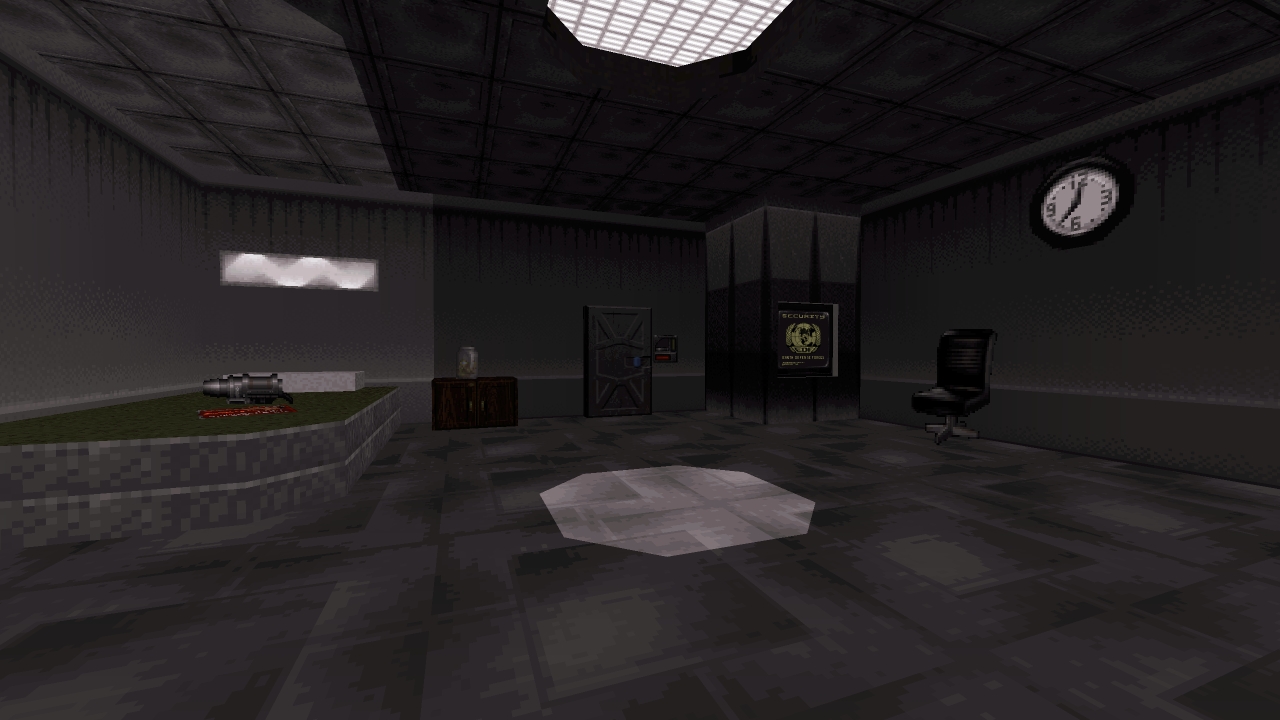
Trial and error is typically the name of the game here as it’s a challenging set of levels that expects adapting to a problem. Getting into the habit to learn the environment and note down where supplies or enemies are located, figuring out a potential solution and considering alternative plans should those not work out. This is a core aspect that Sanek exploits to test his players perseverance to conquer what lies ahead. Saving and reloading can otherwise loosen up the difficulty, I find that starting the level from scratch is usually a better option to perform better than my last attempt. Doing this wasn’t much of a problem considering individual levels have a short length, yet may be seen as repetitious if little progression over the course is being made. Failure is a given, but only those who given up have truly lost.
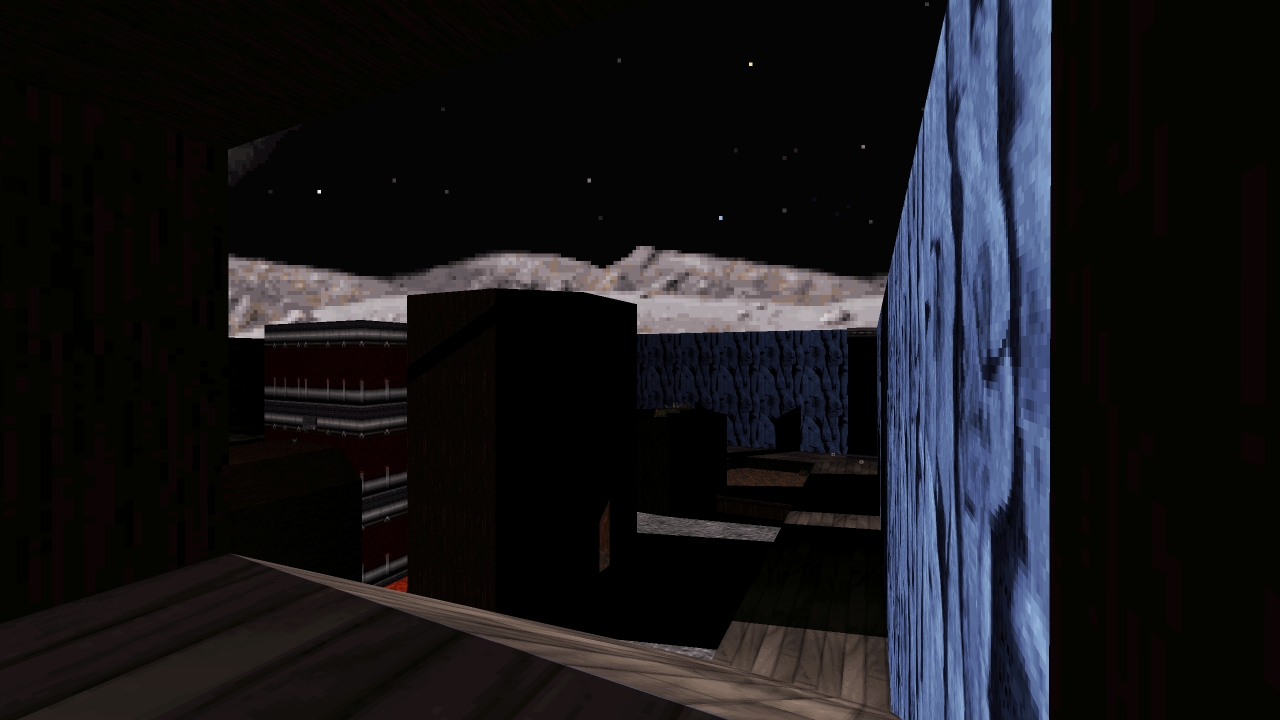
Battlelord health values have been doubled for this episode and can easily become a frustrating enemy to deal with as a result. This is especially true when thrown up against high numbers within inconvenient, narrow spaces. With that in mind, BATTLEDUKE can be demoralising to play. Sadly the enemies in Duke3D are too stupid to navigate levels properly and this weakness can be cheesed without much issue. Sometimes its vital to separate groups by getting individuals stuck trying to reach players through corners. The game may lack Doom’s infighting mechanics, it’s still possible to cause accidental friendly fire which tends to take chunks out of their lifespans. Both exploits can come in clutch to thin out herds when it becomes too much to handle.
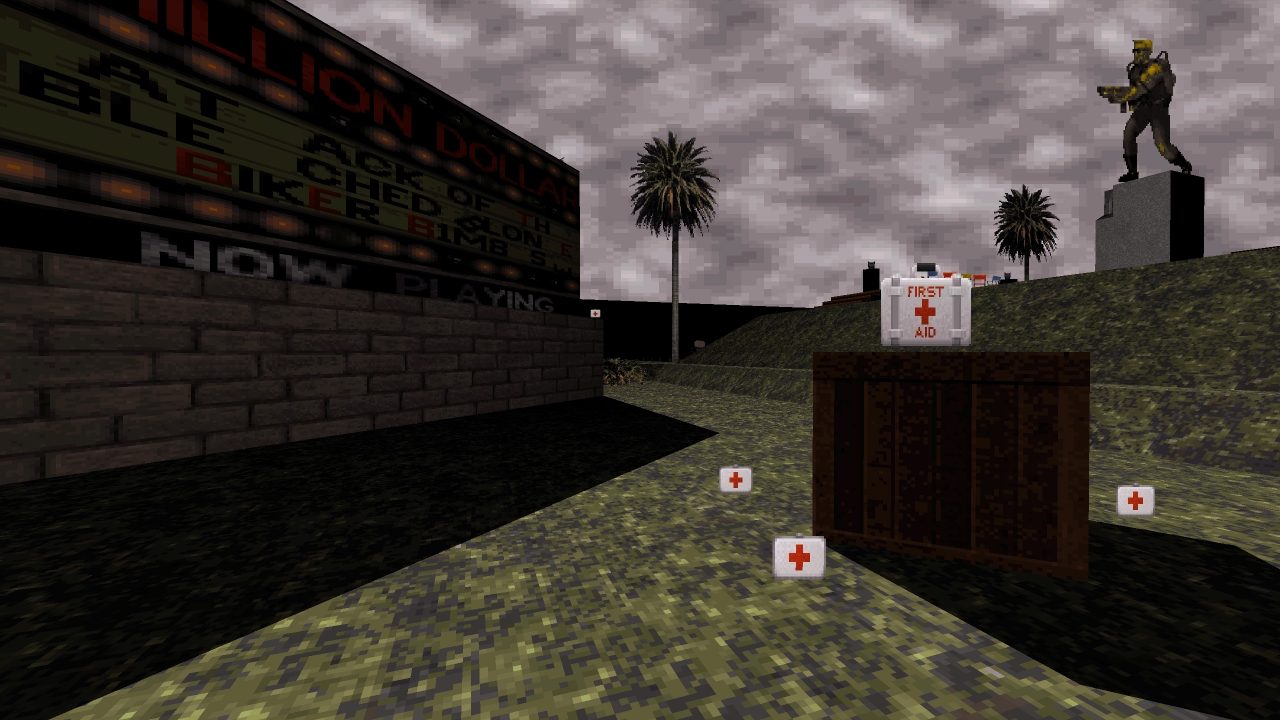
There was only a single time I had the courage to kick a Battlelord to death and that was only from the safety of a vent opening. Doing so only then put into perspective how their increased health solidifies their presence as a constant threat not to be taken lightly. This is a rare exception for me, considering how I dislike the idea of simply increasing health values for enemies as a method to bump up difficulty. It often feels like a lazy effort more often than not causing an imbalance to regular gameplay and becomes a tedious slog. For once I couldn’t hate the idea right away because it makes sense for the gimmick to work well. Battlelords have a nice combat kit, their deadly minigun for swift close quarter kills and an under barrel mortar for nasty long range trickshots. Now that they live longer, there is ample time to show off their usual capabilities to be a pain in the neck, from ground units closing the gap to snipers parked above raining hellfire. The episode’s concept may have become trivial if left at their default values without possibly including higher numbers, but that may have compromised the tight focus. Less is more. By having lower enemy counts per level allows even a singular entity to become a walking disaster if not dealt with accordingly.
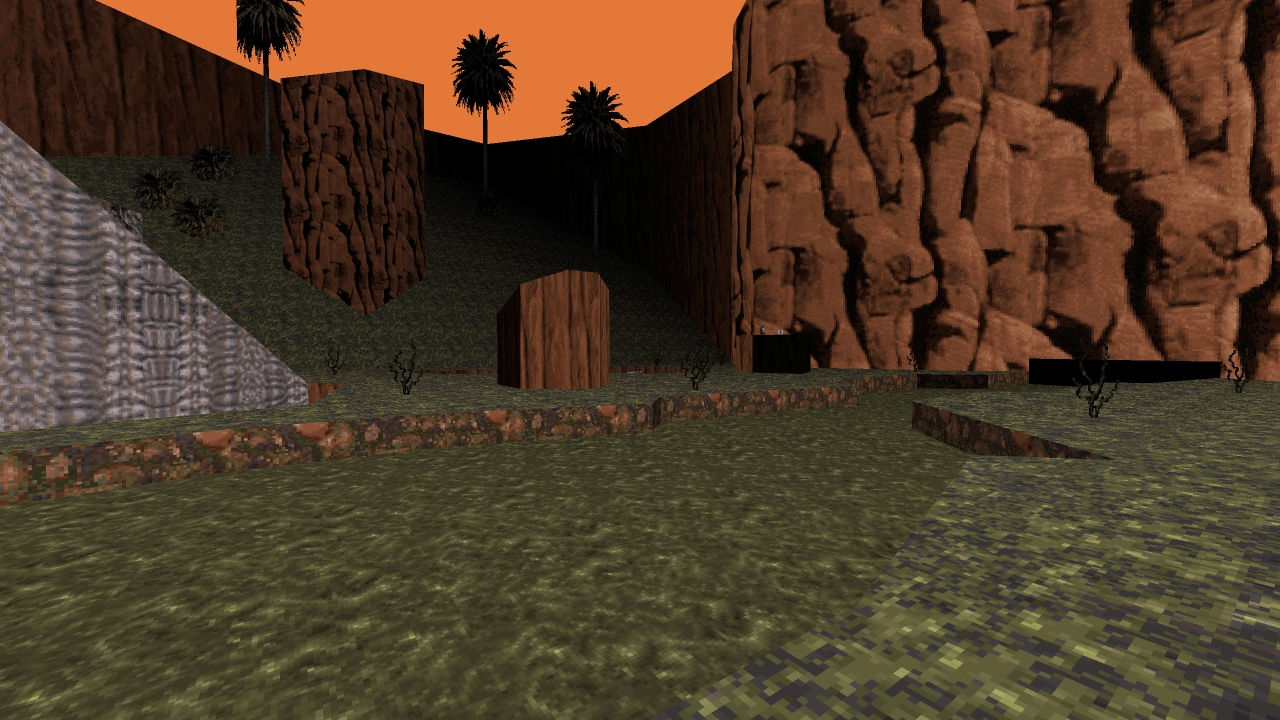
While level concepts may drastically vary, any tactics involving enemy manipulation can still be carried over from one zone into others, albeit with slight differences in their effectiveness. Actions such as baiting friendly fire may work well when foes are allowed to be grouped up, it’s harder to pull off when they’re divided into single units and sentry roles. Defeating every Battlelord isn’t mandatory, but can be seen as a bonus goal left for completionists, which will require using every trick in the book and careful gear management to not be left fighting with just worn out boots. All that matters is that players find their way to the exit in one piece. In an effort to prevent players simply beelining toward the exit once it’s location is known to them, the path is typically locked tight to require certain switch combinations, key cards or activating trigger points first, meaning that executing a solution is just as important as knowing the answer.
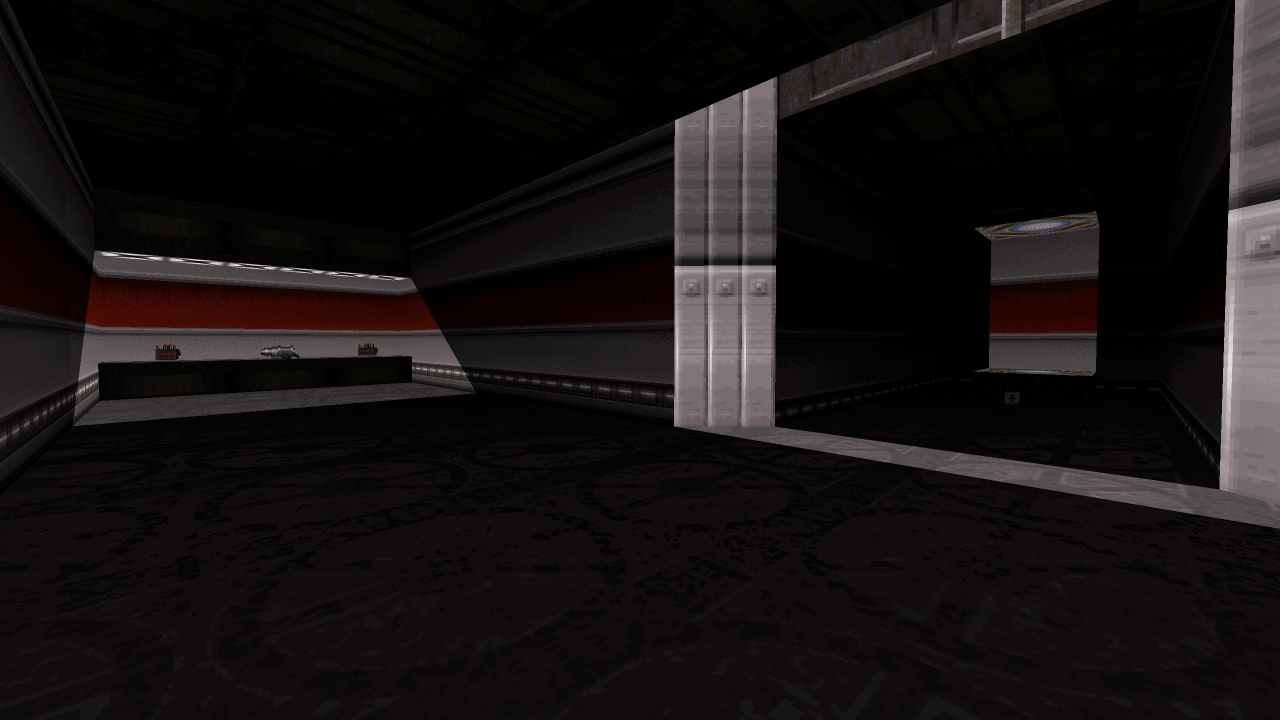
BATTLEDUKE fulfils a niche that doesn’t have many projects using similar concepts and Sanek doesn’t back down from his vision even if that means scaring off potential players. The closest alternative that comes to mind would be Bummed Out by Aymeric Nocus, which instead uses static Cycloids as bombardments and no weapons provided, but does involve other enemy types as well. As much of a unique episode BATTLEDUKE is, it doesn’t go without suffering a few minor hiccups along the way either. The second, third and fifth levels for starters can be boiled down to being too similar, all open arena skirmishes that play around lack of cover or space. WOODSTEROID is the strongest of the three in this style due to its layout and enemy placement having a dynamic that constantly works against the player, leaving the other two to feel as if they’re lacking something by comparison. The finale, HALL OF BATTLES, is also a disappointing way to send off players after finishing an excellent penultimate level, but it’s still not entirely without some merit behind its execution.
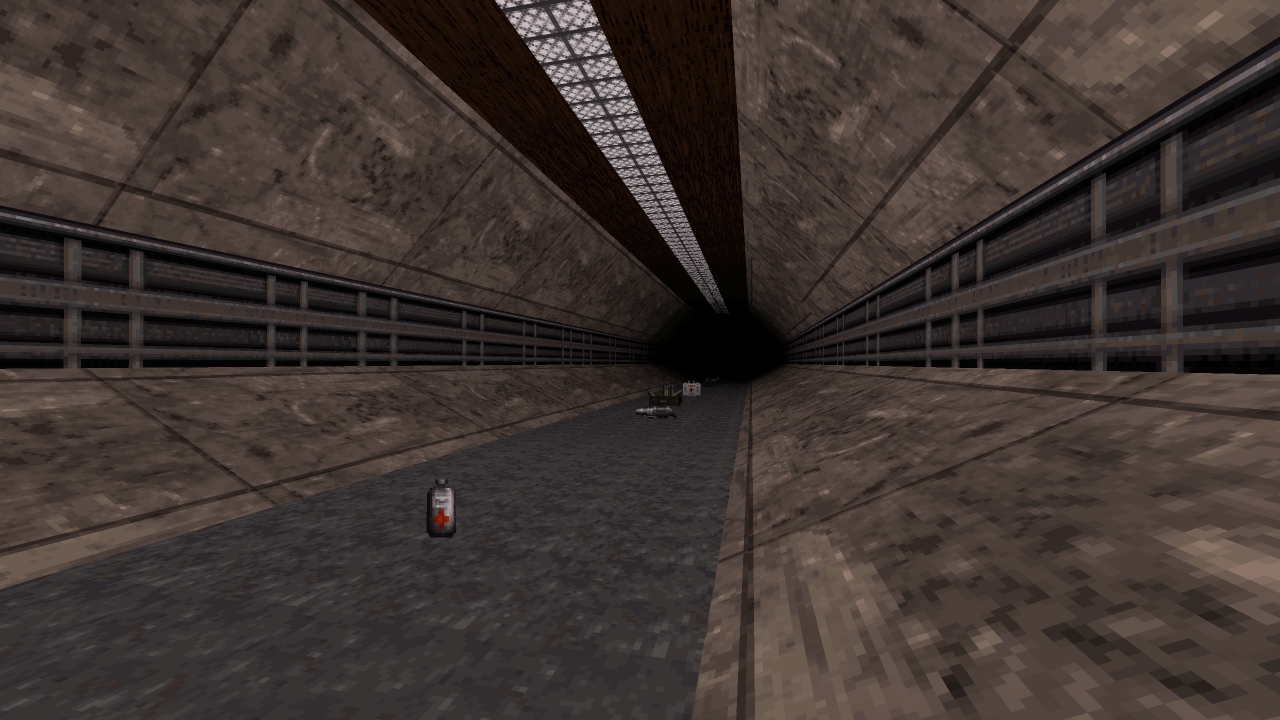
One last concern relates to defeating every Battlelord in each level and the default weaponry to do so, which lack supplementaries by other means to ease combat. The majority of weapons will be hitscan or explosives, where tripbombs underperform and the others simply do their job, nothing more. Exotic arms like the Freezethrower acts as a projectile assault rifle, not really utilising their freezing status potential until a foe is near enough dead. Modifying the base weaponry might have been an answer to reduce some of the tedium and give players options to explore, or designing levels around these new changes. The Shrinker for instance has an improved radius allowing it to affect not only the bosses without issue, but multiple targets in a group. If the Freezethrower could put enemies into a temporary slow state after taking a few shots or Tripbombs now spring some kind of distraction trap, let’s say a photo of Duke flipping them off that drives them made enough to destroy it. Many tactical options open up besides dealing damage if caught in a pinch or to create openings. Of course this all requires extensive additions and testing to work, but possibly something to consider for a sequel to alleviate repetition. For most of BATTLEDUKE’s other issues however, they’re going to lean into either Duke3D gameplay quirks or personal tastes and how much one can stomach dealing with Battlelords for its entire duration. This isn’t your typical Duke3D experience and no one should force themselves into playing it, best enjoyed when taken one step at a time with breaks between levels.
Individual Level Summaries
The following sections below includes a level by level breakdown and will contain spoilers as for what they consist of and my own method at solving these scenarios. Before reading any further, give these levels a chance and enjoy bashing your head against the wall in an effort to conquer them, may very well turn out to be your cup of tea.
We Store Your Space
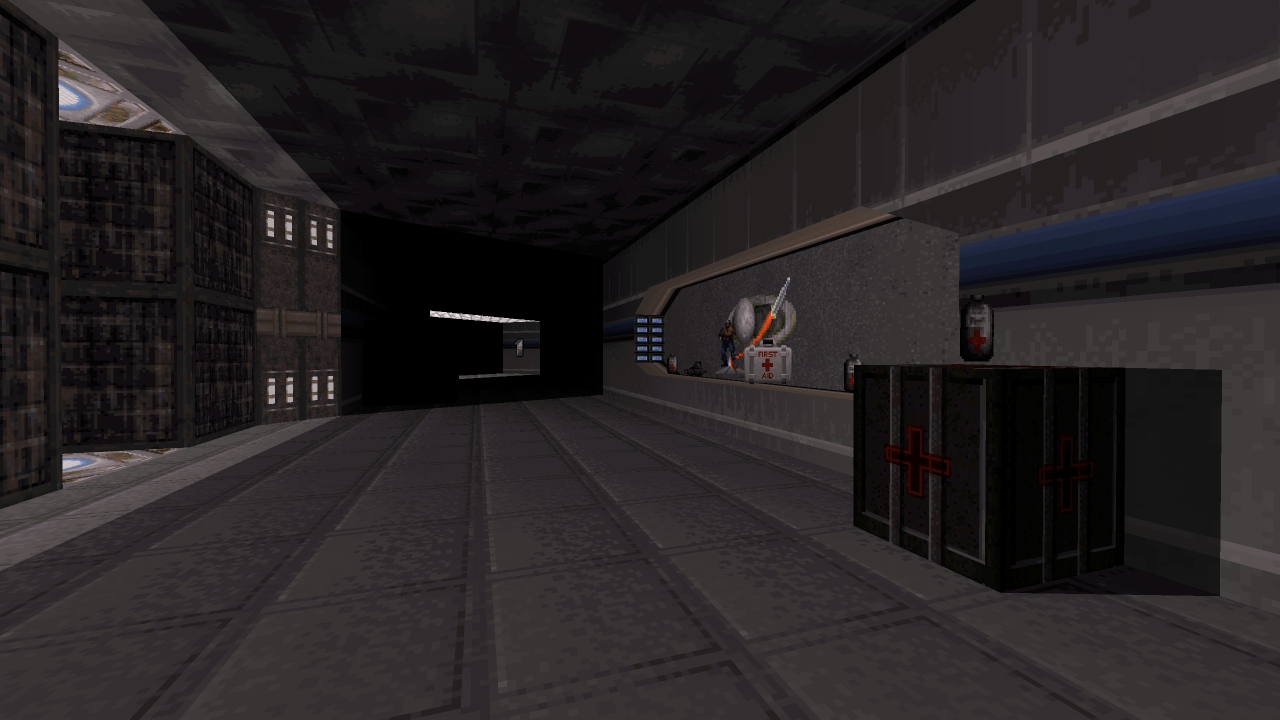
With all said and done BATTLEDUKE’s concept alone was already intimidating enough, that a slow initial build up before coming face to face against our first enemy wasn’t helping matters. WSYS works as a good introduction to how things should work going forward and to teach early on not to become overconfident only by what can be seen. It’s a deceptively simple layout involving a looping corridor and not exactly an overwhelming start if taken at a light jog. Sanek isn’t however ashamed to using all sorts of dirty tricks to keep players on their toes. One lone Battlelord lurks somewhere around the middle point guarding a desirable cache of weaponry, beckoning anyone daring to claim them, which is where the true test then begins. Four additional brutes swarm onto the scene once access upstairs is attained, accompanying the previous foe should he still be left alive, turning this into a constant fight for breathing space before anything else.
Three distinct elements help make this level stand out for me. Crates might seem like a harmless detail providing cover from hitscan fire, they are not guaranteed to block a Battlelords path. They’ve been practising a little parkour recently and keep up the chase by effortlessly hopping right over those obstacles. The crates here cause more harm than good by also creating blind spots for any lingering mortar shells nearby. Another means of escape come from teleporters scattered along the corridors to warp from one side to the other, useful for not only a quick getaway, but useful for luring enemies away. This comes at the risk of being followed into the teleporters too which is always a terrifying thought considering the stakes. Lastly, the Holoduke, item I typically never use in normal play and probably finds a home in the deathmatch scene. Here it became a trusting partner to get some stalkers off my back, an excellent crowd control utility to work out the next step.
Assault on Memorial
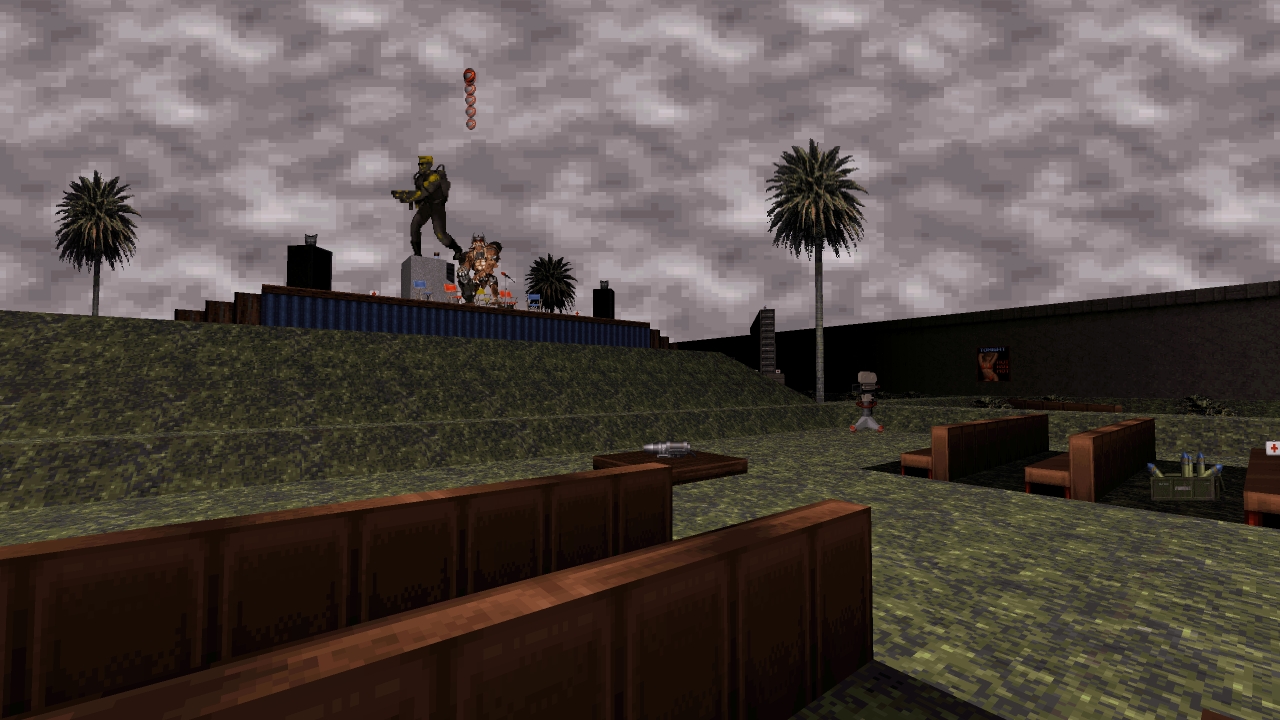
AOM is one of the trickiest levels to get a good run going, starting out on an open field where cover is a premium. Battlelords are already marching forward as they have an easy time catching up to players due to a small arena size, meaning all forms of protection must be earned through a delicate dance alongside uncoordinated partners. It’s a harsh level where I died dozens of times attempting to discover a reliable route. Doesn’t help when one brute, situated at a higher position, is constantly raining hell toward those below. He became an initial target for removal once I settled into a suitable rhythm. Enemy prioritisation and manipulating their positioning seemed to be a key for success here, all without access to a Holoduke for distractions that played an integral factor during the previous level. Another variable to watch out for is taking unwanted chip damage by walking into cacti, moving through lava or fall damage from accidentally waltzing into the monolith without knowing where I’d end up. Once the large gates have been opened, the final barrage of around six screaming miniguns may have looked intimidating at first glance, irony has it that one door at a time would have been the worst scenario. They’re stupid enough to be tricked into shooting each other when all of them awake at the same time, dropping two thirds of their ranks for me, which can turn the tides favourably when exploiting this. Taking big risks in BATTLEDUKE may yield desirable outcomes.
Woodsteroid
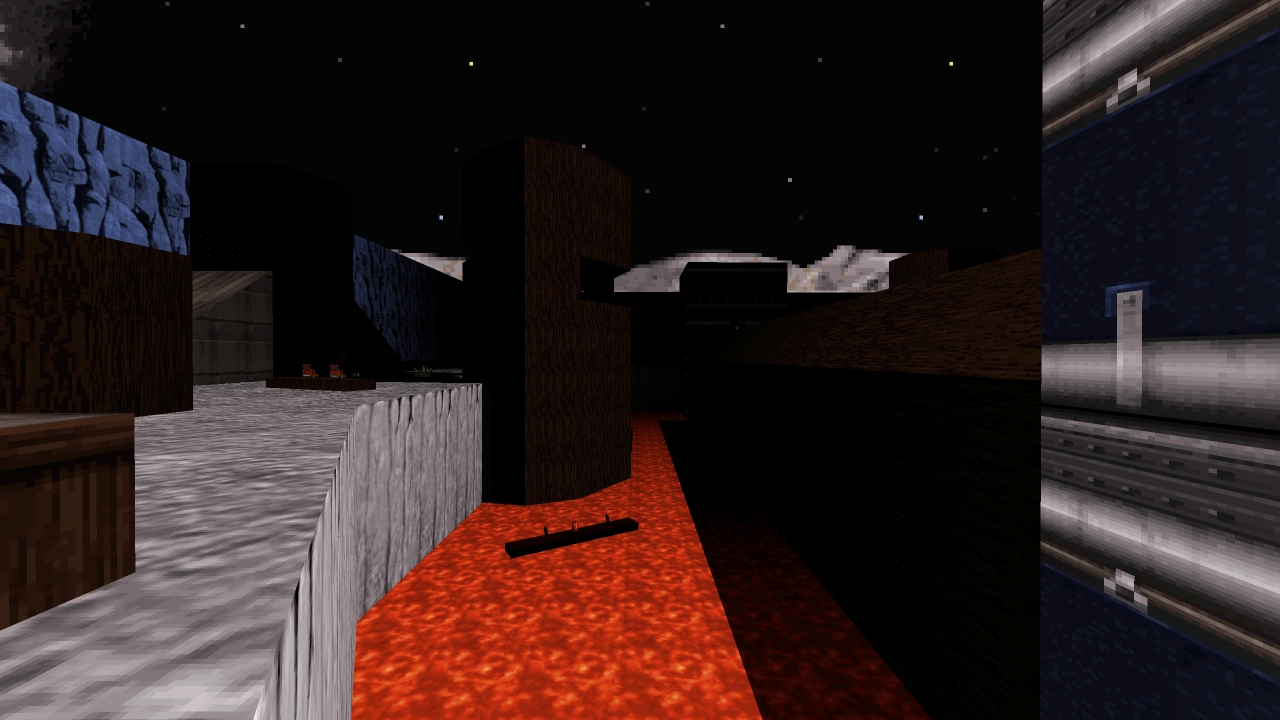
Enclosed within a cold rocky shell, the third level is a strange place with striking visuals. There’s a sharp contrast between light and shadow that creates some unease should a fight break out near darkness. Thick wooden trunks make up some outer structures which have been hollowed out, while the centre houses an underground tunnel and upper platform surrounded by lava. WOODSTEROID is one of the harder challenges embracing exactly how I felt about my first experience playing through Faces of Death; relentless and cruel. The level shares components from the earlier two levels where cover is plentiful and there are options to avoid vulnerable spaces such as teleporters to help move betweens sides of the arena. Steroids are also important as a means to access hard to reach areas needed for a key card and can double as a temporary safety net should foes close in. Battlelords have taken it upon themselves to guard numerous inconvenient positions, where upon any player exposure is just asking for trouble. They are either situated on a higher elevation for effective mortar fire or tucked inside a tight spot, blasting away a chunk the moment you peek around the corner. Then there’s that large lava chasm in the middle to worry about whilst dodging and weaving.
To avoid attracting too much attention I opted for a steady, yet laborious pace by taking down foes one by one. This became problematic since the only means to acquire ample weaponry and supplies is by heading into danger and even then munitions can be very tight, scraping by to defeat the last Battlelord with few bullets to spare. Holding onto any claimed ground becomes a difficult effort for territory control before getting pushed into the open, as without areas to have peace of mind, making progress remains a lost cause. Despite the arduous task required for this journey to reach an end, WOODSTERIOD is an easy favourite amongst all the levels for having a strong foundation and placement of both enemy and resources that has clear understanding how one element interacts against the other for this particular zone. For each Battlelord that blocks progress, that same path also contains the means to deal with the former, denying an easy solution to a problem. Working around and finding alternative answers is at the core what BATTLEDUKE is about and this level is one that succeeds in showcasing that idea.
Tiberius Madness
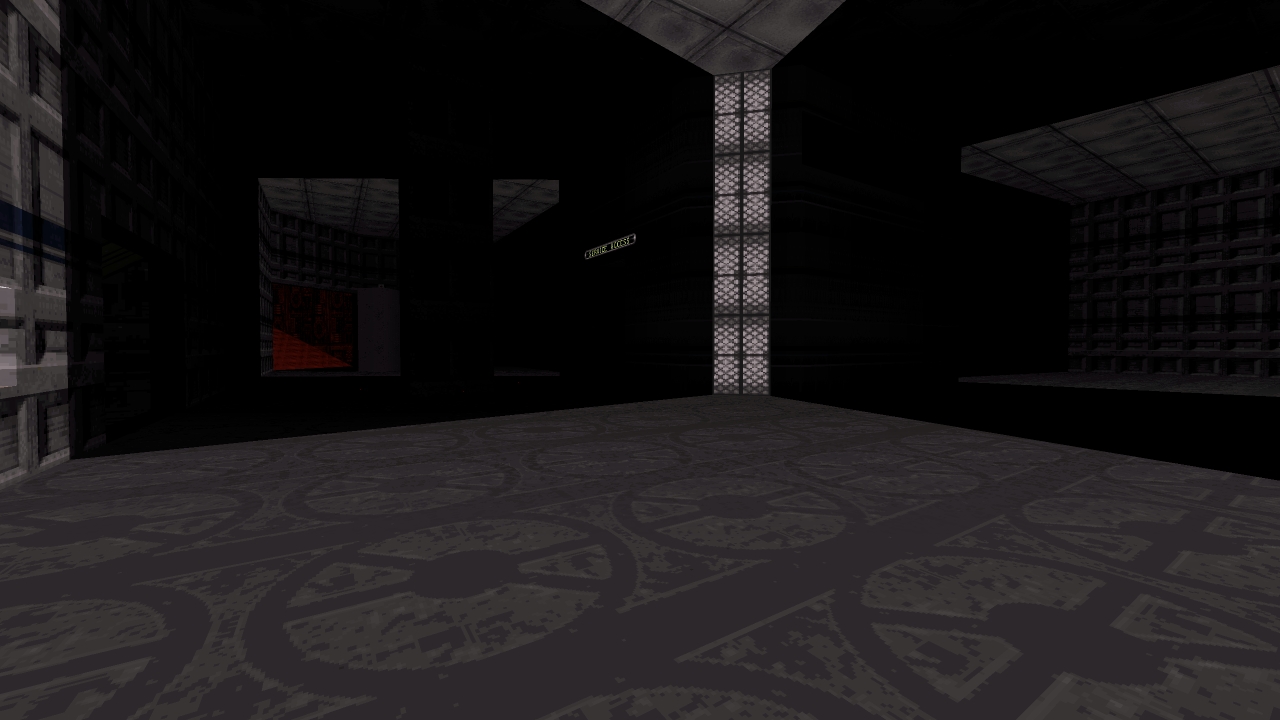
After going through a slow and tedious endeavour to survive the last entry, sometimes taking a break from desperately surviving can help rejuvenate one’s spirits for the journey still to come. Whether that comes in the form of choosing to take time away from playing, it’s nice to know when the author throws you a bone and works wonders for pacing a difficult level set. TM is probably one of the easiest gauntlets that allows players a chance to breath, with favourable options to corral enemies for more suitable fighting conditions. My main tactic would involve luring Battlelords out from their designated hallways and into the central area, then running circles around them while utilising the pillars with Tripbomb manoeuvrers. TM otherwise involves a simple layout with many corridor offshoots that eventually link back around via teleporters or vent shafts. Darkness plays a significant role here to conceal certain traps and enemy placements to ensure there’s some bite left to fear, as it’s easy to lose track of a brute skulking about in the shadows. Nightvision then prove useful here if only because health is always too valuable and goggles are handed out aplenty. Even if gameplay leans toward a more chill vibe, difficulty is still relative to the challenge at hand. Many Battlelords are posted here each guarding a weapon or important item, therefore still involves dealing with them in some manner, all in an effort to snatch up keys and use clues to figure out a button code that may provide a means to the exit.
Jungle Hive
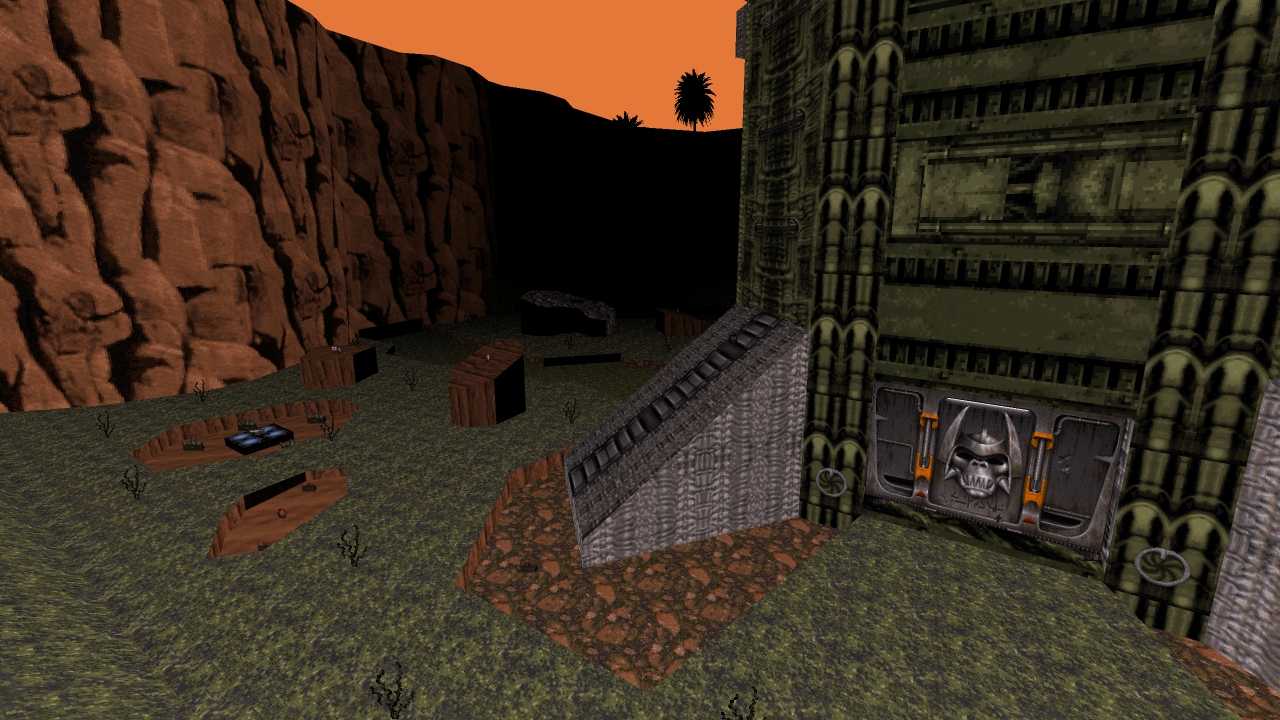
Another familiar challenge to an earlier entry, this one reminds me of an expanded version of the second level, except ironically I would suggest there is less optimal space to work with because of the surrounding hills. Engaging in any fight while moving on a sloped surface was asking for trouble as I wasn’t hitting my targets as accurately and found it better to stay near flat ground. JH encourages spatial awareness of the roaming Battlelords and the bugger up high tossing grenades left and right. There’s also elements causing chip damage like a toxic river and falling from small heights to worry about or whether exploring higher ground for supplies is worth the risks involved. Many of my usual tactics otherwise remain unchanged from prior levels whilst in combat and the only twist that throws a wrench into forming a pattern is when the central tower doors are unlocked. Once in this phase, available cover is reduced as an additional vanguard join the frenzy. Of course, suspecting another trap here, I had already rigged up my own elaborate tripwire setup around the doors, only for some rogue mortar shell to blow that plan up into smoke. Too bad that, once again, enemies in Duke3D are stupid enough to mince through their own allies weakening the intended roster for the finale. It’s also cathartic grabbing the Shrinker so close to the ending and getting a small taste of its improved capabilities, only for Sanek to violently rip it from your hands, laughing maniacally. There’s simply no easy path in BATTLEDUKE.
Hunter or Prey
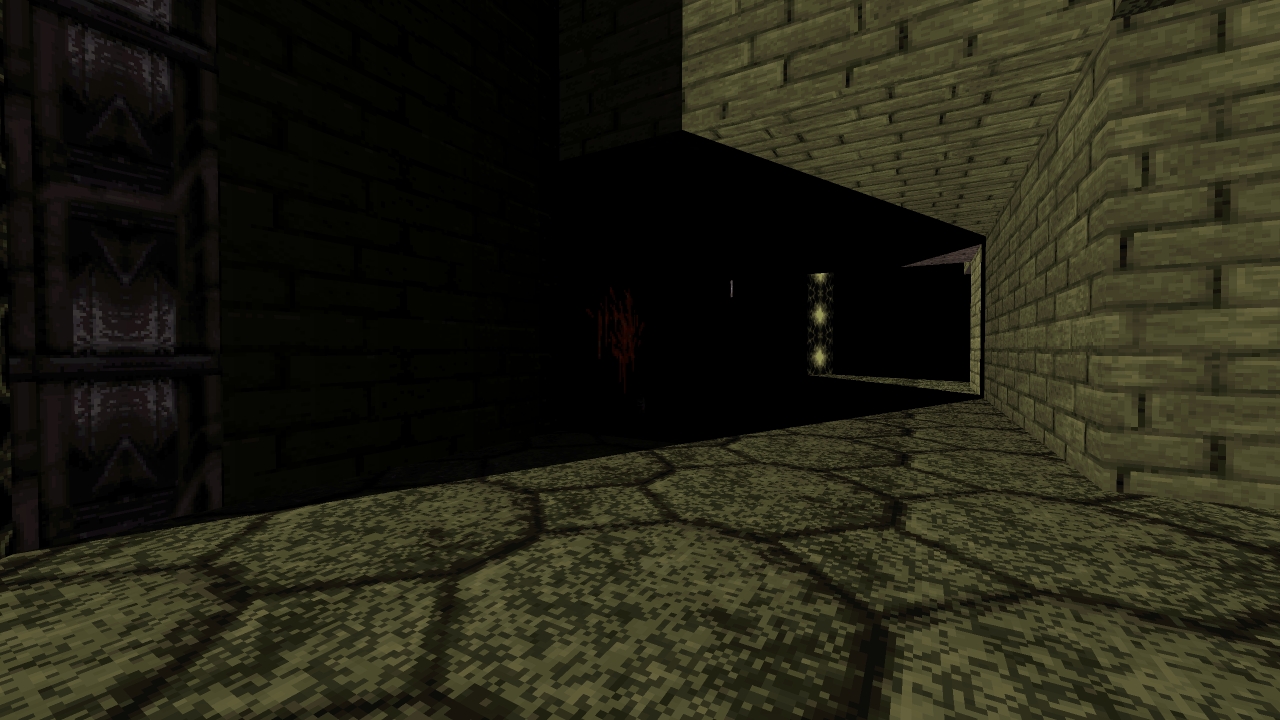
The penultimate level is an excellent culmination of everything BATTLEDUKE stands for and remains the hardest trial to overcome of all seven entries. Duke has fallen into the enemy’s trap, captured and imprisoned to never see daylight again. Nothing of use can be seen from within the dark cell, besides whatever remains of its prior inhabitants and graffiti providing a miniscule hope of freedom. HOP paints a hostile picture, instilling fear by providing no weapons or gear from the start, knowing exactly what is waiting up ahead having made it this far. Left to ponder on options during the crawl forward, there’s no telling what to expect without clues, before emerging into a network of open hallways. Then a familiar battle cry shatters the silence to initiate this one sided hunt. There was only one priority left on my mind, to run blind into the unknown. Lack of visibility here is a hindrance to overcome, as darkness and flashing lights obscure the way forward, purposely utilised to not only throw players off at every turn, but to further heighten hostility. The message is clear as day; we are not welcome here.
Battlelords dominate these halls. This is their territory and they await in the most awkward of places, usually down long stretches given them ample time to ram some lead into players unprepared. I died, a lot. Dozens and dozens of times. HOP is a very trial and error heavy experience where foreknowledge becomes the key to success, since executing your next planned manoeuvrer is still a raw component for the long run. It very much reminds me of elements taken from Doom’s Plutonia level, “Hunted” and Doom64’s “Cat & Mouse”. By all accounts this experience should have been a frustrating mess, but in reality it wasn’t for mine. I always knew there had to be an intentional method here and was just a matter of finding something that works well through experience. Keeping tabs on enemy positions, what gear is available and which routes are the safest to procure them. After much perseverance I found a cache of Holodukes, a good place to save progress as a new jumping off point. If the first level taught me anything, I landed on a goldmine.
Progression from here is a demanding process, ignoring the obvious problems. Because each chamber holds within them weapons and access codes to unlock another, they’re an important focal point. These same codes are then inputted around the centre, at a four way intersection, where who knows how many Battlelords could now be loitering from their random wanderings. Trekking down one path to get there could also reawaken a sleeping foe tucked within a wall niche, so travel always remains uncertain and dangerous if they aren’t dispatched, munitions withstanding. I’m always kept on edge and enjoyed every moment the level threw at the wall to see what would stick. If the first half was being thrown into a fiery blaze, the second phase is like being swept up by a freezing torrent. It’s a nasty scenario where all the prior non-linear space suddenly becomes linear, with a new wave of Battlelords beaming down a single path reducing every inch that remains between me and them. This was a race against time, a single minded rush to shoot everything I have before getting pushed into a dead end. Tension is always high, but dominating this level felt rewarding.
Halls of Battles
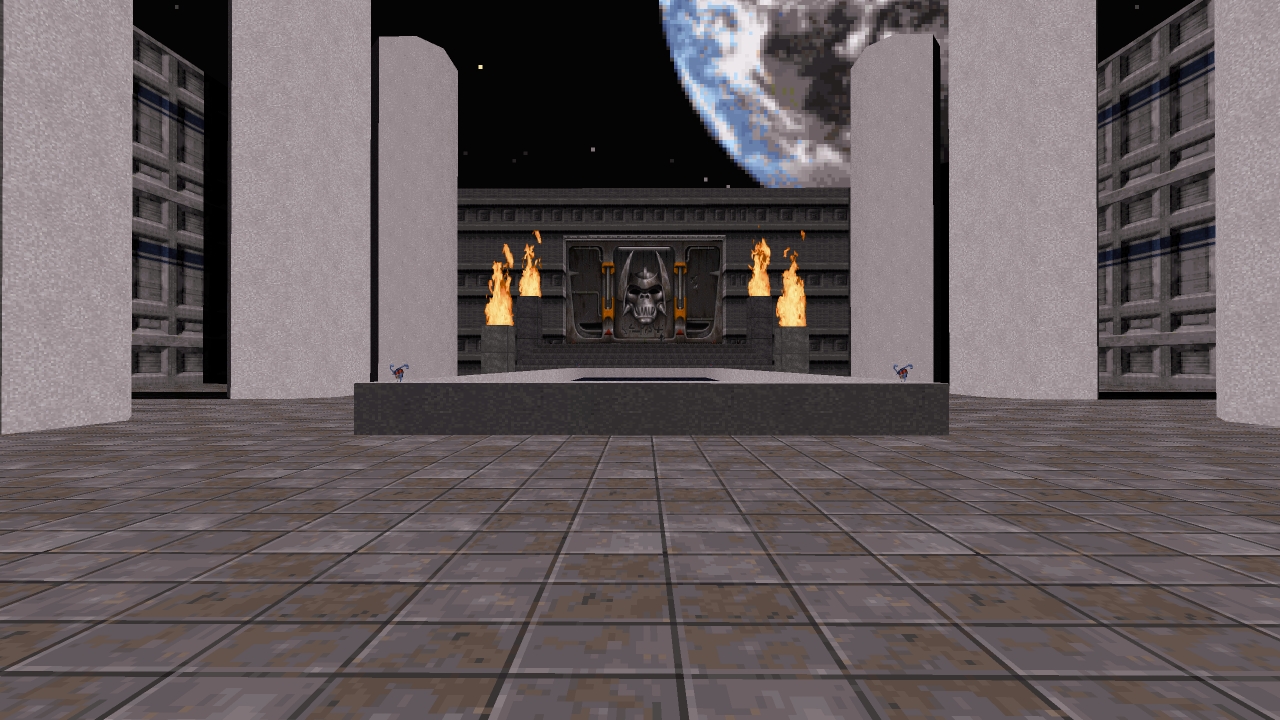
By the end of the last level and loading one final adventure, I feared the episode was going to end on a rather unremarkable final boss encounter after an excellent yet miserable gauntlet just moments before. But there’s more under the surface here than it seems and glad my assumption is proven incorrect after the initial simplistic presentation is what edged me toward this negative bias. As you head toward the battle arena an arsenal surplus is revealed and once outside, a massive stone palace serves as the place to fight against several regular Battlelords tagging along side a larger final boss variant. Ammo is tight, good management is necessary to defeat every one left standing and have enough spare for the big guy himself. Smarter play and applying the lessons learnt up until this point can help a lot, such as friendly fire and taking advantage of the Shrinker’s larger blast radius. Health wasn’t a major concern as long as I avoided close quarter fights, using the pillars as cover when needed. Squashing any shrunk opponents struck too many close calls with the Boss who wanted to do the same, sometimes forcing me to not take the risk and try later.
Conclusion
I like how the project name that suggests both a Lord versus Duke feud, and as if the term “Battle” is a title given to those who excel after proving their strength, whereupon defeating every adversary and coming out on top will declare you as the BattleDuke. Seven levels is long enough for the concept to not over stay its welcome, yet what was on offer provided a refreshing twist to explore an ignored concept. Seeing how far Sanek could push the idea in both subtle and forthright ways was fascinating, yet there’s bound to be more potential seeping under the surface. We Store Your Space, Woodsteroid and Hunter or Prey are great examples that standout, showcasing experiences unique to them in particular.
Sure enough BATTLEDUKE can be a tedious, frustrating and in some cases a little dry at times, but Faces of Death as a level theme hasn’t been explored much at all, this project serving as a stepping stone for a niche little sub-set of levels to change up the usual type of DUKE3D releases now and then. Seeing additional levels based around certain special effects, other inventory items usage or further modifications to accentuate the base weaponry might provide scope for expansions to the concept in future. I’m glad Sanek in the end stuck with his intended vision to see how far this concept could be pushed beyond leaving it confined to a single infamous level.